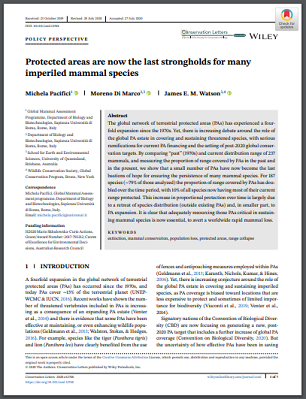
The global network of terrestrial protected areas (PAs) has experienced a fourfold expansion since the 1970s. Yet, there is increasing debate around the role of the global PA estate in covering and sustaining threatened species, with serious ramifications for current PA financing and the setting of post-2020 global conservation targets. By comparing “past” (1970s) and current distribution range of 237 mammals, and measuring the proportion of range covered by PAs in the past and in the present, we show that a small number of PAs have now become the last bastions of hope for ensuring the persistence of many mammal species. For 187 species (∼79% of those analyzed) the proportion of range covered by PAs has doubled over the time period, with 10% of all species now having most of their current range protected. This increase in proportional protection over time is largely due to a retreat of species distribution (outside existing PAs) and, in smaller part, to PA expansion. It is clear that adequately resourcing those PAs critical in sustaining mammal species is now essential, to avert a worldwide rapid mammal loss.














